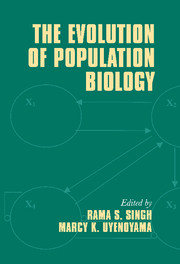Book contents
- Frontmatter
- Contents
- List of contributors
- Publications of R. C. Lewontin
- Preface
- Introduction
- Part I Historical foundations and perspectives
- Part II Genotypes to phenotypes: new genetic and bioinformatic advances
- Part III Phenotypes to fitness: genetics and ecology of populations
- Part IV Genes, organisms, and environment: evolutionary case studies
- 14 Adaptation, constraint, and neutrality: mechanistic case studies with butterflies and their general implications
- 15 Evolution in hybrid zones
- 16 Nine relatives from one African ancestor: population biology and evolution of the Drosophila melanogaster subgroup species
- Part V Applied population biology: biodiversity and food, disease, and health
- Index
15 - Evolution in hybrid zones
Published online by Cambridge University Press: 08 January 2010
- Frontmatter
- Contents
- List of contributors
- Publications of R. C. Lewontin
- Preface
- Introduction
- Part I Historical foundations and perspectives
- Part II Genotypes to phenotypes: new genetic and bioinformatic advances
- Part III Phenotypes to fitness: genetics and ecology of populations
- Part IV Genes, organisms, and environment: evolutionary case studies
- 14 Adaptation, constraint, and neutrality: mechanistic case studies with butterflies and their general implications
- 15 Evolution in hybrid zones
- 16 Nine relatives from one African ancestor: population biology and evolution of the Drosophila melanogaster subgroup species
- Part V Applied population biology: biodiversity and food, disease, and health
- Index
Summary
Introduction
Hybrid zones have been investigated for more than 70 years, yet the fascination that they hold for evolutionists shows no sign of diminishing. This fascination is easy to understand; not only are hybrid zones common evolutionary phenomena (Hewitt 1988) worthy of understanding on their own right, their study can provide insight into the nature of species (Harrison 1990), the genetic architecture of species differences (Harrison 1990, Rieseberg et al. 1999), the role of natural selection in maintaining species boundaries (Bigelow 1965, Barton and Hewitt 1981a) and the evolution of reproductive isolation (Howard 1993, Noor, 1999). Although studies of hybrid zones have a rich history, students entering the field have a strong tendency to focus on the most recent literature, with the consequence that through time the older literature becomes neglected and its findings lost. This is not a problem unique to the field of hybrid zone studies; it afflicts all of biology. The present chapter provides a brief introduction to hybrid zones and the evolutionary questions they present. It is written in the spirit that the old hybrid zone literature is worthwhile and many of its conclusions relevant to issues of current interest. We hope that it stimulates evolutionists to delve further into a body of work that deserves wider recognition.
- Type
- Chapter
- Information
- The Evolution of Population Biology , pp. 297 - 314Publisher: Cambridge University PressPrint publication year: 2004
- 3
- Cited by



